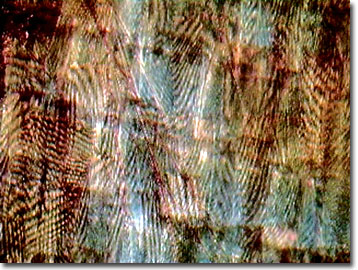Butterfly Wing Scale Digital Image Gallery
Lilac Beauty Butterfly
When at rest in the tropical rainforests of sub-Sahara Africa, the lilac beauty hides it velvety colors. The upper sides of its wings exhibit a stunning combination of dark and light browns with iridescent bronze and purple highlights, but the undersides demonstrate muted hues. In combination with false leaf veins, a median rib, and irregular edges, the tranquil insect often appears as a brittle or torn leaf to potential predators.

Lilac beauties are members of the brush-footed butterfly family, Nymphalidae, and consist of two described subspecies. The upper sides of the wings of the western subspecies display a broad sub apical orange band bordered in black and three, small white apical spots. The eastern subspecies lacks the orange band and features richer violet hues. The wing coloration and patterns are similar for both sexes of lilac beauty butterflies, but the females are generally larger in size.
Common names are not always sufficient for identifying butterfly species. This lilac beauty is scientifically described as Salamis cacta, but another lepidopteran species, Apeira syringaria, bears the same common moniker. The genus Salamis, known as the mother-of-pearl butterflies, includes eight other species, all from tropical Africa, south of the Sahara Desert. Salamis cacta are most often seen flying in the shady portions of African forests, but once settled, the butterflies are resistant to disturbance and may remain still for long periods of time.
An increase in ecological awareness has aided the survival of the lilac beauty butterfly despite its damage causing larvae. The agricultural pests are often exposed to harsh insecticides because one of their primary food plants is rattan, which is economically important in some areas of Africa. Over collection and destruction of habitat have also been problematic for the species, but breeding and rearing of lilac beauties on butterfly ranches helps alleviate some of the population pressures. However, butterfly safaris in Ghana and Kenya may best assure the continued existence of the lilac beauty and its native habitat.
Contributing Authors
Cynthia D. Kelly, Shannon H. Neaves, Laurence D. Zuckerman, and Michael W. Davidson - National High Magnetic Field Laboratory, 1800 East Paul Dirac Dr., The Florida State University, Tallahassee, Florida, 32310.
BACK TO THE BUTTERFLY WING SCALE IMAGE GALLERY
BACK TO THE DIGITAL IMAGE GALLERIES
Questions or comments? Send us an email.
© 1995-2025 by Michael W. Davidson and The Florida State University. All Rights Reserved. No images, graphics, software, scripts, or applets may be reproduced or used in any manner without permission from the copyright holders. Use of this website means you agree to all of the Legal Terms and Conditions set forth by the owners.
This website is maintained by our
Graphics & Web Programming Team
in collaboration with Optical Microscopy at the
National High Magnetic Field Laboratory.
Last Modification Friday, Nov 13, 2015 at 01:19 PM
Access Count Since January 21, 2003: 9455
Visit the website of our partner in introductory microscopy education:
|
|
